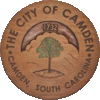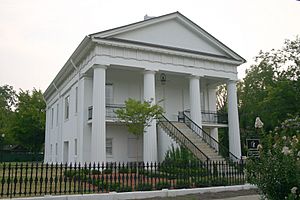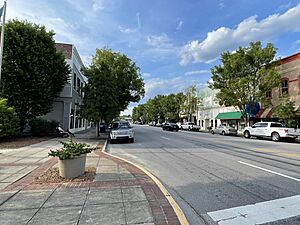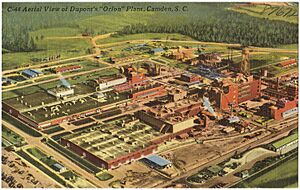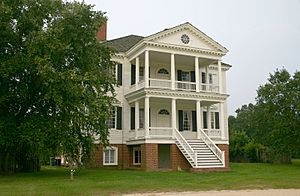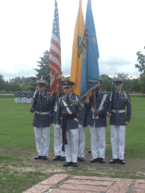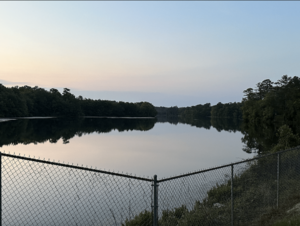Camden, South Carolina facts for kids
Quick facts for kids
Camden, South Carolina
|
||
|---|---|---|
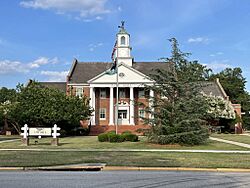
Camden City Hall
|
||
|
||
| Nickname(s):
Steeplechase Capital of the World
|
||
| Motto(s):
"Classically Carolina"
|
||
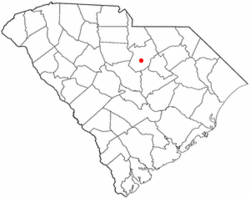 |
||
| Country | United States | |
| State | South Carolina | |
| County | Kershaw | |
| Founded | March 22, 1786 | |
| Government | ||
| • Type | City manager-council | |
| Area | ||
| • Total | 11.90 sq mi (30.82 km2) | |
| • Land | 11.11 sq mi (28.77 km2) | |
| • Water | 0.79 sq mi (2.05 km2) | |
| Elevation | 187 ft (57 m) | |
| Population
(2020)
|
||
| • Total | 7,788 | |
| • Density | 701.18/sq mi (270.72/km2) | |
| Time zone | UTC−5 (Eastern) | |
| • Summer (DST) | UTC−4 (Eastern) | |
| ZIP codes |
29020 & 29021
|
|
| Area code(s) | 803, 839 | |
| FIPS code | 45-10855 | |
| GNIS feature ID | 1247113 | |
Camden is the largest city and the county seat of Kershaw County, South Carolina. In 2020, about 7,788 people lived there. Camden is part of the larger Columbia, South Carolina, Metropolitan Statistical Area. It is the oldest inland city in South Carolina. Camden is also famous for horse racing, especially the Carolina Cup, and is home to the National Steeplechase Museum. It's often called the "Steeplechase Capital of the World."
Contents
About Camden's Location
Camden is located in the central part of South Carolina, in an area called the Midlands. It sits on the northeast side of the Wateree River. This river flows south and joins the Santee River. The city covers about 11.9 square miles (30.82 square kilometers). Most of this area is land, with a small part being water.
Major roads connect Camden to other cities. U.S. Route 521 goes through downtown Camden. It connects the city to Sumter to the southeast and Charlotte, North Carolina to the north. US Route 1 also crosses through downtown. It links Camden to Columbia, the state capital, to the southwest. Interstate 20 passes just south of Camden. This highway makes it easy to travel east to Florence or southwest to Columbia.
City Areas
Camden has several distinct neighborhoods:
- East Camden
- Knights Hill
- Dusty Bend
- Windsor Heights
- White Gardens
- Arrowwood
- The RaceTracks
- Sunnyhill
Camden's History
Camden is South Carolina's oldest city that isn't on the coast. It's also the fourth oldest city in the entire state.
Early Days and Colonial Times
The area where Camden is now was once home to the Cofitachequi chiefdom in the 1500s. In 1730, King George II of Great Britain planned to create new towns inland. Camden was part of this plan. It was first called Fredericksburg in 1732. However, settlers preferred higher ground nearby.
In 1758, a man named Joseph Kershaw from England opened a store here. He renamed the town "Pine Tree Hill." It quickly became an important trading center for the colony. Later, Kershaw suggested renaming it "Camden." This was to honor Lord Camden, who supported the American colonies in the British Parliament.
American Revolution and Growth
The American Revolution reached Camden in May 1780. British forces, led by Lord Charles Cornwallis, took control of Charleston, South Carolina. They then marched to Camden and made it their main supply base for the war in the South.
Two important battles happened near Camden. The Battle of Camden on August 16, 1780, was a big loss for the American forces. On April 25, 1781, the Battle of Hobkirk's Hill took place. American troops, led by General Nathanael Greene, fought against British soldiers. The British won, but it cost them many soldiers. This forced them to leave Camden and move closer to the coast.
After the Revolution, Camden became even more important. It was a major trading town connected directly to Charleston. Goods from inland areas were sent down the Wateree River to Charleston. This trade helped Camden grow wealthy.
Civil War and Modern Era
During the American Civil War, six Confederate generals came from Camden. At the end of the war, parts of Sherman's army burned buildings in Camden. This included a whole block of downtown shops.
In the late 1800s, wealthy families from the North started visiting Camden in the winter. It became a popular resort town. Camden is now known for its many horse activities. It has one of the oldest active polo fields in America. More than 1,500 thoroughbred horses spend their winters in the area. This strong connection to horses is why Camden is called the "Steeplechase Capital of the World."
In 1950, the Dupont company opened a large plant in Camden. It made a material called Orlon and employed over 2,000 people. This plant was the town's biggest employer for many years. Dupont stopped making Orlon in 1990 due to competition. Since then, other manufacturing companies like Hengst GmbH & Co. and Haier have come to Camden. In 2003, Target also opened a large distribution center here.
Jewish Community
Camden has a long history of having a Jewish community. Famous people from this community include Bernard Baruch, a well-known financier and presidential adviser.
Population Information
| Historical population | |||
|---|---|---|---|
| Census | Pop. | %± | |
| 1850 | 1,133 | — | |
| 1860 | 1,621 | 43.1% | |
| 1870 | 1,007 | −37.9% | |
| 1880 | 1,780 | 76.8% | |
| 1890 | 3,533 | 98.5% | |
| 1900 | 2,441 | −30.9% | |
| 1910 | 3,569 | 46.2% | |
| 1920 | 3,930 | 10.1% | |
| 1930 | 5,183 | 31.9% | |
| 1940 | 5,747 | 10.9% | |
| 1950 | 6,986 | 21.6% | |
| 1960 | 6,842 | −2.1% | |
| 1970 | 8,532 | 24.7% | |
| 1980 | 7,462 | −12.5% | |
| 1990 | 6,696 | −10.3% | |
| 2000 | 6,682 | −0.2% | |
| 2010 | 6,838 | 2.3% | |
| 2020 | 7,788 | 13.9% | |
| U.S. Decennial Census | |||
What the 2020 Census Shows
In 2020, Camden had 7,788 residents. There were 2,905 households and 1,810 families living in the city.
| Race | Number of People | Percentage |
|---|---|---|
| White (not Hispanic) | 4,744 | 60.91% |
| Black or African American (not Hispanic) | 2,367 | 30.39% |
| Native American | 13 | 0.17% |
| Asian | 68 | 0.87% |
| Pacific Islander | 1 | 0.01% |
| Other/Mixed | 257 | 3.3% |
| Hispanic or Latino | 338 | 4.34% |
What the 2010 Census Shows
In 2010, Camden had 6,838 people. About 62.2% of the population was White, and 35.1% was African American. About 2.4% of the people were Hispanic or Latino.
The average age in Camden was 45.3 years old. About 21.9% of the population was under 18. About 45% of the population was male and 55% was female.
Education in Camden
The Kershaw County School District manages the public schools in Camden. These include several elementary schools, Camden Middle School, and Camden High School.
There are also private schools in Camden. These include Camden Military Academy, the Montessori School of Camden, and Cornerstone Christian School.
For higher education, Central Carolina Technical College has two campuses in Camden. The city also has a public library, which is part of the Kershaw County Library system.
Arts and Fun Activities
The Carolina Cup
The Carolina Cup is a very popular annual horse racing event. It takes place every spring, usually in late March or early April. The first race was held in 1930. It's a big tradition in South Carolina, drawing over 70,000 spectators. The race is held at the Springdale Race Course, just north of Camden. The National Steeplechase Museum is also located nearby. It's important to know that gambling on horse racing is not allowed in South Carolina.
Irish Fest Camden
Every year on the first Saturday of March, Camden hosts Irish Fest Camden. This festival celebrates Saint Patrick's Day and Irish culture. Over 2,000 people come to enjoy live Irish music and dancing. There's also a "Lucky Leprechaun 5K race," athletic games, a kids' zone, and food trucks.
Revolutionary War Field Days
Historic Camden holds its signature event, Revolutionary War Field Days, every November. Hundreds of people dress up as soldiers and reenact battles from the American Revolutionary War. Visitors can watch battles and walk through the camps. They can also see demonstrations of old crafts and skills. Scholars give talks about the war, making it a fun and educational event.
Transportation
- Seaboard Air Line Railway Depot - A historic train station.
- Woodward Field (Kershaw County Airport) - The local airport for smaller planes.
Local Media
The Chronicle-Independent is Camden's local newspaper. It has been serving the community since 1889. There are also two radio stations in Camden: WPUB-FM, which plays oldies music, and WCAM 1590, which plays adult standards music.
Famous People from Camden
Many notable people have connections to Camden:
- Thomas Austin – An NFL player.
- Bernard Baruch – A famous financier and adviser to presidents.
- Brook Benton – A well-known singer.
- Mary Chesnut – An author famous for her Civil War diary.
- Larry Doby – The first African American to play in the American League of baseball. He is in the Baseball Hall of Fame.
- Bobby Engram – An NFL player.
- Vonnie Holliday – An NFL player.
- Joseph Brevard Kershaw – A lawyer, judge, and general.
- Lane Kirkland – A leader of the AFL–CIO union.
- Michael Kohn – A Major League Baseball player.
- Kathleen Parker – A journalist and Pulitzer Prize winner.
- Vincent Sheheen – A state senator.
- John C. West – A former Governor of South Carolina.
- Lois Rhame West – Former First Lady of South Carolina.
- Johnson Chesnut Whittaker – One of the first black men to attend the United States Military Academy at West Point.
- Samuel E. Wright – An actor and Broadway performer.
See also
 In Spanish: Camden (Carolina del Sur) para niños
In Spanish: Camden (Carolina del Sur) para niños


